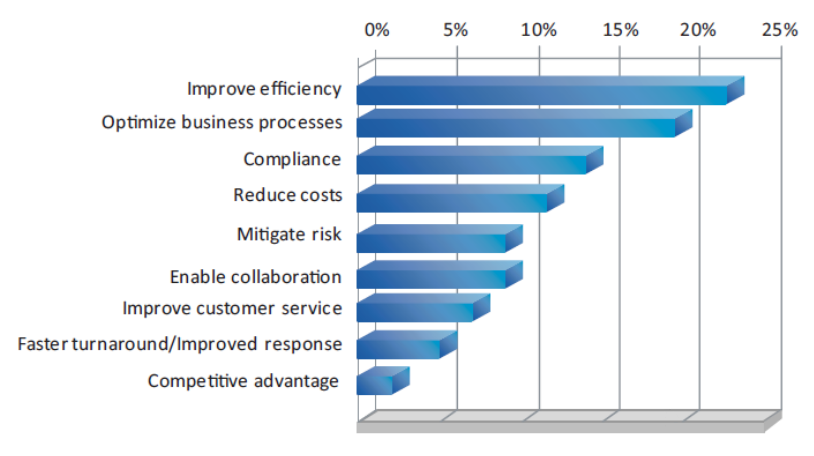Organized management and a good visual of your content gives you an edge over your competitors and this feeds the concern over when you should migrate to your new Enterprise Content Management (ECM) System . The whole process requires a huge capital investment and do not forget disrupting your business which can in turn spoil your customer’s digital experience. Before you go looking for a new ECM system to develop your new platform, you should consider an assessment of your current system that takes a comprehensive view of your current tools and processes. This assessment will cover a similar ground as the ECM system selection process and also gives the possibility that the best platform may be the one you already have.
If you go to a grocery store hungry, you will end up buying things you don’t actually need. Most smart people avoid this by making a list of essentials. When it comes to selecting a new ECM system, documenting your needs is an absolute necessity. Comparing your existing ECM system to the functionalities you are hoping for, is a matter of magnitude. By considering each area carefully, your organization can make the best strategic decision possible and get the most value from the ECM system you implement. Now assessing the implementation is the matter of measuring this magnitude which we cover in the following six points:
Integration of ECM system with your Business process
The main aim of integrating your business with an ECM system would be to content-enable the business applications so that the latest and most accurate information is readily available.
Unstructured content can be scattered across various repositories which can happen due to individual applications having their own stores for related information.
Significant cost savings can be achieved when the core business applications are organized and content enabled. This improves efficiency(Fig 1.1) and reduces reliance on paper and also lowers physical storage.

Fig 1.1: The most significant business drivers for document and records management (Source: AIIM, State of the ECM Industry 2011)
Although the ability to organize and structure pages is not required now, it might be needed in future. Always look out for CMS which do not allow flexibility for such core tasks.
Core ECM Capabilities
As the company grows, so does the variety of content that needs to be archived and content that needs to be disposed off. A good ECM system should be able to manage the entire lifecycle of various content types and support other processes like search, retention and rendering associated with the content types and also let you define each step of the content’s lifecycle.
Records Management and retention policies helps control the creation, classification, declaration, retention, and destruction of content and records, resulting in improved compliance, minimum litigation risk, and lower storage costs.
Basic functionalities to consider include:
Search- full-text search, filtered search results for end-users to quickly find what they have authorized access to, and advanced search capabilities like custom search forms and metadata search.
Metadata, Classification and Taxonomies- Support for automated, manual and inherited metadata values on all types of content and classification of content based on these values.
Versioning-automatic tracking and storage of each file version along with auditing, archiving and the ability to revert to a previous version of a document if needed.
Rendition support-the ability to automatically generate content in other formats (PDF, XML, HTML).
Compound document support – to allow smaller documents to be incorporated within a master or parent document.
Ease of Access (multi-channel content creation & consumption)
A good ECM system allows your employees or users to access information from various devices. These days it is important to make your information accessible through mobile devices. Whether it is for intranet, ethernet or mix of both, access to content in this context adds significant value.
A CMS implementation has three primary requirements: developer’s needs, user experience and the content author’s needs to maintain the user experience.
The user’s and developer’s needs usually become the focus of an ECM System implementation, but the process doesn't end when it goes live.
Content Authoring Workflow
The CMS of choice should also have expandable workflow capacity to meet the future needs of your business. Analyzing the workflow of your organization helps you select a better suited ECM System.
If your authors face difficulty working with your new ECM System, it’s implementation might not serve your purpose well. A discontent from the author community will affect the business as your system is starved of new content and you might go through another cycle of a new CMS implementation.
Encourage author adoption of the new ECM System by both training and considering various functionalities of your new ECM System that your authors require.
These functionalities can be types of content that can be submitted, provision of author tools (eg: SEO, spell check, standard taxonomies, compliance tools, auto-complete of metadata items), a suitable permission model to hide irrelevant features from the author etc.
Enterprise-Class Capabilities
The ability of an ECM System to grow and adapt to your business’s growing needs in a way that it does not bring up limitations is one critical factor to be considered. Also, it should not add significant support costs in future.
You new ECM system is going to be the information backbone of your company and should meet certain requirements:
Scalability- It should be able to scale thousands of users and billions of content types and also manage the lifecycle of these information efficiently.
Security- Admin’s ability to define access to various types of information based on the type of user, different groups across the organization or an end user. A good ECM System will have data encryption and restrictions on database access to provide optimum level of security.
Managing,Auditing and Reporting- A unified administration has better manageability and lower costs. Having a lone platform that allows an admin to manage all the information, services and reports and logs from a single console reduces staffing requirements and improves compliance by eliminating the creation and enforcement of redundant policies and procedures.
Multilingual support- To reach the world wide audience an organization requires localization support for a number of languages and the ability to adapt to different time zones.
Service Oriented Architecture (SOA)- The ECM System’s ability to integrate with various types of systems is essential to ensure that your content is readily available across the enterprise.
Strength of Vendor
You ECM system provider should have the commitment, longevity and the financial strength to be your business partner for years to come. While evaluation a suitable vendor, you should consider:
- The available educational and training materials
- Training personnel
- Availability of global tech support.
- Ability of address issues in a timely manner.
- Availability of other implementation partners and subject matter experts globally.
Conclusion
Whether you are considering an upgrade to your current ECM System, a replacement of an older system or the purchase of a completely new ECM System, there are many important criteria involved in electing the best content management system suited for your organization. Apart from the 6 points mentioned here there might be other requirements which will build your list further. We hope you find this useful and consider Valuebound to build your future. More information on our work is available at Valuebound.



